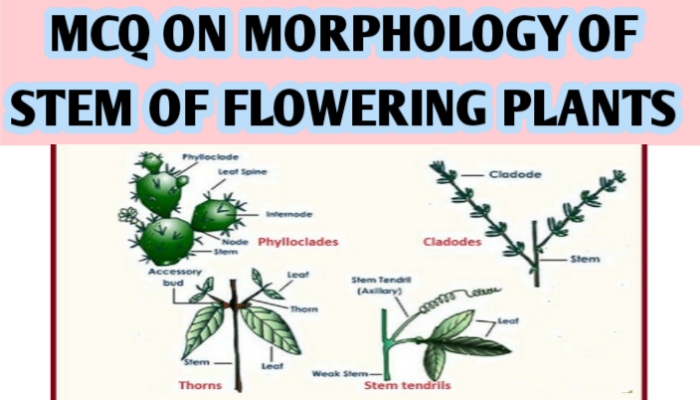MCQ ON MORPHOLOGY OF STEM OF FLOWERING PLANTS class 11 for NEET | Morphology of STEM of flowering plant class 11 MCQ | MORPHOLOGY OF STEM OF FLOWERING with Answer | Check the below NCERT MCQ question for class 11 Biology chapter 5 based on MORPHOLOGY OF STEM OF FLOWERING PLANTS with Answers.

MCQ ON MORPHOLOGY OF STEM OF FLOWERING PLANTS
MCQ on Morphology of STEM of Flowering Plants class 11 Biology with answers were prepared based on the latest pattern.
We have provided class 11 Biology MCQs questions on MORPHOLOGY OF STEM OF FLOWERING PLANTS with Answers to help students understand the concept very well.
MCQ on MORPHOLOGY OF STEMS OF FLOWERING PLANTS is useful for NEET / CSIR / UGC / CBSE / ICSE / AIIMS / EXAM / AFMC EXAM / STATE LEVEL/ JAC exam MEDICAL EXAM 2022-23
Introduction:-
A stem is the main ascending axis of a plant which develops from the plumule and epicotyl of the emryo. In flowering plants , it bears leaves , branches , flowers and fruits.
It has nodes and internodes which distinguish it from other plant parts even if it happens to be an underground stem.
The young stem is green and photosynthetic , the lateral organ of stem are exogenous in origin.
MCQ ON MORPHOLOGY OF STEMS OF FLOWERING PLANTS class 11 for NEET
1. The ascending part of the axis bearing branches, leaves , flowers and fruits .
(a) root
(b) stem
(c) leave
(d) all the above
Ans (b) stem
2. Stem develops from
(a) radicle
(b) plumule
(c) tendrils
(d) all the above
Ans. (b) plumule
3. Stem bears
(a) nodes
(b) internodes
(c) buds
(d) all the above
Ans. (d) all the above
4. The stem tendril from
(a) terminal buds
(b) axillary buds
(c) thorns
(d) all the above
Ans.(b) axillary buds
ALSO READ:-
● YOU CAN WATCH BIOLOGY SIR Youtube channel
5. Tendrils help plants to climb such in gourds
(a) cucumber
(b) pumpkin
(c) watermelon
(d) all the above
Ans.(d) all the above
6.Thorns are found in
(a) citrus
(b) Bougainvillea
(c) both a and b
(d) all the above
Ans.(c) both a and b
7. The main function of the stems are
(a) It conducts water
(b) storage of food
(c) support and protection
(d) all the above
Ans.(d) all the above
8. Flattened stem
(a) opuntia
(b) euphorbia
(c) colocasia
(d) all the above
Ans.(a) opuntia
9. Fleshy cylindrical stem
(a) opuntia
(b) colocasia
(c) euphorbia
(d) all the above
Ans. (c) euphorbia
10. Stem contain chlorophyll and carry out photosynthesis
(a) opuntia
(b) euphorbia
(c) colocasia
(d) both a and b
Ans. (d) both a and b
11. Underground stems found in
(a) grass
(b) strawberry
(c) both a and b
(d) colocasia
Ans.(c) both a and b
12.In plants like mint and Jasmine a slender lateral branch arise from the
(a) base of the main axis
(b) root
(c) tendrils
(d) all the above
Ans.(a) base of the main axis
13. A lateral branch with short internodes and each node bearing a rosette of leaves and a tuft of roots is found in aquatic plants like
(a) pistia
(b) eichhornia
(c) banana
(d) bith a and b
Ans.(d) both a and b
14. The lateral branches originate from the basal in
(a) banana
(b) pineapple
(c) chrysanthemum
(d) all the above
Ans.(d) all the above
15. Corm is modification of
(a) root
(b) leaf
(c) stem
(d) bud
Ans. (c) stem
16. Tendril in passiflora develop from ?
(a) apical roots
(b) apices of roots
(c) axillary buds
(d) terminal buds
Ans.(c) axillary buds
17. Example of corm is
(a) ginger
(b) colocasia
(c) onion
(d) potato
Ans.(b) colocasia
18. Cladode is a characteristic morphological feature of
(a) asparagus and ruscus
(b) casuarina and opuntia
(c) cladophora and cactus
(d) citrus and euphorbia
And.(a) asparagus and ruscus
19. Stems modified into flat green organs performing the function of leaves are known as ?
(a) phyllides
(b) phylloclades
(c) scales
(d) cladodes
Ans. (b) phylloclades
20.The eye of the potato tubers are
(a) root buds
(b) flower buds
(c) shoot buds
(d) axillary buds
Ans.(d) axillary buds







Leave a Comment